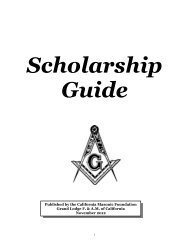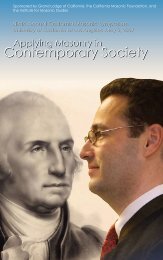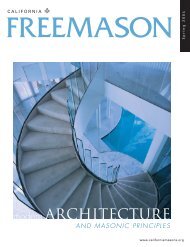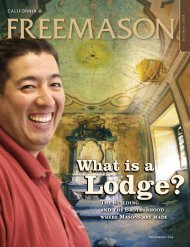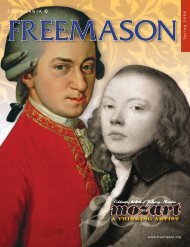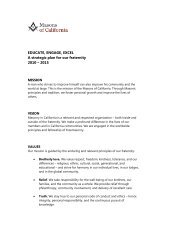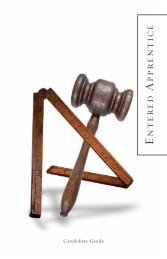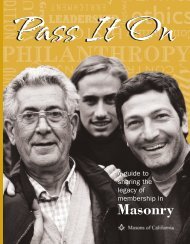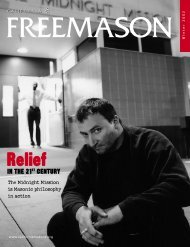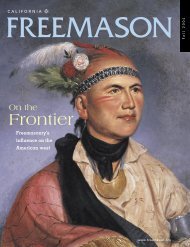Winter 2004 - Freemason.org
Winter 2004 - Freemason.org
Winter 2004 - Freemason.org
Create successful ePaper yourself
Turn your PDF publications into a flip-book with our unique Google optimized e-Paper software.
HISTORY<br />
Solution,” which was the latest in a long<br />
line of theories about the identity of the<br />
famous killer. Unlike previous books on<br />
the topic, however, Knight did not pin<br />
the blame on a single person. Instead, he<br />
focused on a wide-ranging conspiracy<br />
to murder prostitutes who knew a dark<br />
secret about the royal family. Knight, who<br />
had a history of mental-health problems,<br />
epilepsy, and brain tumors, posited that a<br />
group of high-level Masons orchestrated<br />
the ritual slayings of the women in order<br />
to protect Prince Eddy, heir to the throne<br />
of England. Based on the commercial<br />
success of this book, he went on to write<br />
“The Brotherhood: The Secret World of<br />
the <strong>Freemason</strong>s,” which claimed that<br />
Masonry was working in conjunction with<br />
the Soviet KGB to control the world.<br />
Knight’s work inspired award-winning<br />
comic-book writer Alan Moore to explore<br />
the story of Jack the Ripper. Moore had<br />
already established an international<br />
reputation for creating dark, often violent,<br />
graphic novels for adults, and recreating<br />
the shadowy world of Victorian England<br />
in the context of the Whitechapel murders<br />
was a natural fit for his brooding style.<br />
He selected noted artist Eddie Campbell<br />
to bring his dystopian vision to life, and<br />
in 1988—exactly a century after the<br />
Ripper murders terrorized London—their<br />
collaborative effort, “From Hell,” was<br />
published. It became one of the most<br />
successful comics in history and was<br />
adapted to the silver screen in 2001.<br />
From his home in Brisbane, Australia,<br />
Campbell told California <strong>Freemason</strong><br />
how “From Hell” incorporated Masonry<br />
into the narrative. “We were interested in<br />
Stephen Knight’s work in the first place,<br />
but I don’t believe most of what he says.<br />
It’s what we were interested in initially, but<br />
we looked at other sources, too.”<br />
In fact, Moore freely admits in the 42<br />
pages of detailed research notes that<br />
California <strong>Freemason</strong> 8 <strong>Winter</strong> <strong>2004</strong><br />
The lodge room is a setting in Alan Moore’s graphic novel “From Hell,” brought to life<br />
by Eddie Campbell’s illustrations.<br />
accompany the comic that the bulk of<br />
“Jack the Ripper: The Final Solution” may<br />
have been an “ingenious hoax,” and he<br />
clearly does not consider Knight’s book to<br />
be a definitive history of the Whitechapel<br />
murders. Campbell points out that “From<br />
Hell” is a work of fiction inspired by<br />
real events. “There are a lot of theories<br />
about these crimes, but none of them are<br />
conclusive. What we really created was a<br />
look at the abuses of power and influence.<br />
We weren’t out to solve the mystery.”<br />
Masonic imagery and symbolism<br />
play a critical role in the film version<br />
of “From Hell.” Early in the movie the<br />
camera zooms in on the killer’s medical<br />
kit emblazoned with the square and<br />
compass, and throughout the movie a<br />
group of prominent men, ranging from<br />
senior police officials to elected officials<br />
to British nobles, meet in a subterranean<br />
chamber and invoke the name of the<br />
Great Architect.<br />
When confronted about the crimes, Sir<br />
William Gull proclaims that he is “a Mason<br />
fulfilling a duty.” Unlike Knight’s book,<br />
which portrays Masonry in an entirely<br />
negative way, “From Hell” manages to<br />
redeem the craft. Gull’s Masonic brethren<br />
are aghast at his crimes, and the film<br />
ends with the doctor receiving horrific<br />
retribution from his “circle of friends.”<br />
As with all theories about the identity<br />
of Jack the Ripper, the Gull angle proved<br />
to have a short shelf life. Only a year after<br />
“From Hell” was released, noted crime<br />
novelist and forensic scientist Patricia<br />
Cornwell used archived documents and<br />
DNA samples to posit that the real killer<br />
was an artist named Walter Richard<br />
Sickert. Sickert’s name has long been<br />
associated with the killings, and many<br />
Ripperologists have long felt that he could<br />
have been the murderer. Nevertheless,<br />
Cornwell’s book immediately became<br />
the subject of intense scrutiny, and few<br />
devotees of the Whitechapel murders are<br />
willing to concede that the case is closed.<br />
So who was the real Jack the Ripper, and<br />
what motivated him to kill and mutilate<br />
his anonymous victims? After remaining<br />
open for more than a century, it is unlikely<br />
that the case will ever be solved with any<br />
degree of certainty. Moore and Campbell<br />
dedicated “From Hell” to the murder<br />
victims, saying “you and your demise:<br />
Of these things alone we are certain.<br />
Goodnight, ladies.”




